[one_half padding=”0 15px 0 0″]DE: Getting back to trade-offs with on-chip phase-detect AF, one of the big differences between the on-chip phase-detect and the conventional separate phase-detect sensors is that the conventional sensors have much larger pixels, and are consequently more sensitive to light compared to on-chip PD elements. So there’s a tradeoff in light sensitivity if you go to on-chip. What’s the low-light limit for the NX1?[/one_half][one_half_last padding=”0 0px 0 15px”]DE: 回到芯片相位对焦的取舍上,芯片式相位检测和传统的分离式相位检测的重要区别之一就是传统的对焦传感器上的像素要大得多,因此和芯片式相位对焦相比对光线更敏感,所以如果选择了芯片对焦,会在光线灵敏度上有所牺牲。NX1弱光极限怎么样?[/one_half_last]
[one_half padding=”0 15px 0 0″]JK: I believe it is rated to EV-4 for contrast and EV-2 for P.D. But the tradeoff isn’t in the size of the phase-detect sensors, as you move from off-chip to on-chip. It comes in wavelength. So with the DSLR phase-detect sensors, you can run those wide open. You can run them into infrared, and that’s what most designers do. So if you look at DSLR autofocus assist lights, many are running red-infrared, which is less obtrusive. The autofocus assist lights are generally red-infrared, but if you go on-chip you have the IR blocking filter on the image sensor, so on-sensor you can’t use IR sensing for autofocus any more.[/one_half][one_half_last padding=”0 0px 0 15px”]JK: 我想经过测试的对比度检测达到EV-4,相位检测达到EV-2,但从分离式转移到芯片式牺牲的不是相位传感器的大小,而是波长。在数码单反上,你可以最大限度地利用相位检测传感器,它可以检测红外线—-大部分设计者是这么做的。如果你观察数码单反的自动对焦辅助光,许多都是不怎么明显的红光到红外光。通常自动对焦辅助光都是红光到红外光,但是如果选择了芯片式,在图像传感器前面就有红外截止镜,所以在芯片上就不能再靠感应红外光来自动对焦了。[/one_half_last]

[one_half padding=”0 15px 0 0″]DE: Ah![/one_half][one_half_last padding=”0 0px 0 15px”]DE: 啊![/one_half_last]
[one_half padding=”0 15px 0 0″]JK: Make sense. Because you’re blocking the IR.[/one_half][one_half_last padding=”0 0px 0 15px”]JK: 说明白点,因为需要阻挡红外光。[/one_half_last]
[one_half padding=”0 15px 0 0″]DE: Yeah, obviously, yeah.[/one_half][one_half_last padding=”0 0px 0 15px”]DE: 对,很显然,对的。[/one_half_last]
[one_half padding=”0 15px 0 0″]JK: And so, the right strategy for on-chip AF assist ends up being visible spectrum, or in our case we’ve been using green lights for a long time. Now, the green light that’s in this one for AF assist is the most powerful AF assist light I’ve ever seen; it’s good out to 15 meters.[/one_half][one_half_last padding=”0 0px 0 15px”]JK: 所以最后可见光才是芯片式AF辅助的正确方向,对我们来说我们长久以来一直使用绿色光。现在NX1中的用作AF辅助的绿光是我见过的最强大的AF辅助光,有效距离能达到15米。[/one_half_last]
[one_half padding=”0 15px 0 0″]DE: Wow.[/one_half][one_half_last padding=”0 0px 0 15px”]DE: 哇。[/one_half_last]
[one_half padding=”0 15px 0 0″]JK: We’ve also added in a pattern…[/one_half][one_half_last padding=”0 0px 0 15px”]JK: 我们还加入了图形……[/one_half_last]
[one_half padding=”0 15px 0 0″]DE: Yeah, it has that patterning; perhaps using a holographic grating or something to project the pattern.
[Sony used a holographic grating to project an AF pattern a few years back, but it didn’t persist in their product line. The reason I’m thinking they might be using a holographic grating to project it is that the pattern seems to stay pretty sharply-focused, regardless of the distance it’s being projected.][/one_half][one_half_last padding=”0 0px 0 15px”]DE: 对,有特定图形,也许是用了全息光栅什么的来投射这个图形。
[索尼几年前用过全息光栅投射AF图形,但没有在它的产品线上继续使用下去。我想原因可能是他们的全息光栅投射的图形过于集中了,不顾投射的距离。][/one_half_last]
[one_half padding=”0 15px 0 0″]JK: It’s a line pattern, let me see if I can dial that up. Here, look at this, Dave. If you look at the back of your computer actually. [He’s projecting the AF-assist pattern on the lid of my MacBook.][/one_half][one_half_last padding=”0 0px 0 15px”]JK: 是线形的,我看看是不是能按出来。这里,Dave,看这个,看你电脑的背面。[他在我MacBook的盖子上投射AF辅助光的图形。][/one_half_last]
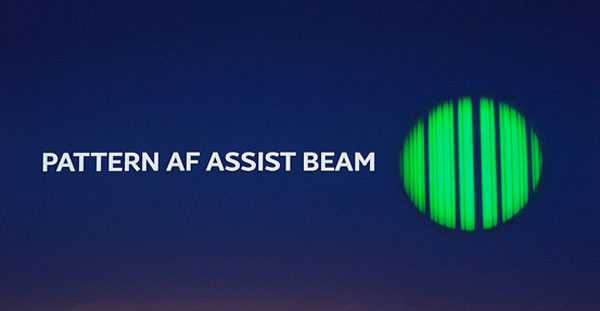
[one_half padding=”0 15px 0 0″]DE: Yeah, it’s got a whole bunch of vertical lines, both broad lines and fine lines. Presumably the broad lines help when the camera’s more out of focus, and the fine ones help it focus finely, once it’s close …[/one_half][one_half_last padding=”0 0px 0 15px”]DE: 对,有一大堆竖线,有粗有细。想必粗线是在相机离焦点位置比较远的时候起作用,细线帮助相机在接近焦点位置的时候精确对焦。[/one_half_last]
[one_half padding=”0 15px 0 0″]JK: Well, if you’re in total darkness, you need a pattern.[/one_half][one_half_last padding=”0 0px 0 15px”]JK: 唔,如果在全黑的环境下,你就需要图形了。[/one_half_last]
[one_half padding=”0 15px 0 0″]DE: Yeah.[/one_half][one_half_last padding=”0 0px 0 15px”]DE: 是的。[/one_half_last]
[one_half padding=”0 15px 0 0″]JK: Total darkness on a flat surface.[/one_half][one_half_last padding=”0 0px 0 15px”]JK: 全黑的平滑表面上。[/one_half_last]
[one_half padding=”0 15px 0 0″]DE: Right, the projected pattern means you’re not dependent on the surface that you’re aiming it at.[/one_half][one_half_last padding=”0 0px 0 15px”]DE: 对,投射图形意味着你不再依靠相机对准的表面了。[/one_half_last]
[one_half padding=”0 15px 0 0″]DE: When we were talking previously, you said that the architecture of DRIMe V is very different than DRIMe IV. What sorts of changes are made between them?[/one_half][one_half_last padding=”0 0px 0 15px”]DE: 我们之前谈到,你说DRIMe V的架构和DRIMe IV有很大区别,到底是什么样的变化呢?[/one_half_last]
[one_half padding=”0 15px 0 0″]JK: The biggest change is the structure of the Image Signal Processor. The DRIMe V ISP is very different. Most ISPs have key parts of the processing hardwired to get the needed speed. What’s really new with the DRIMe V is that the “hardwiring” can be reconfigured.[/one_half][one_half_last padding=”0 0px 0 15px”]JK: 最大的改变是图像信号处理器的结构。DRIMe V的ISP(图像信号处理器,译者注)是很不一样的。多数ISP的关键部分是获得必要速度的处理硬连线,DRIMe V真正新颖的地方是”硬连线”可以被重新配置。[/one_half_last]
[one_half padding=”0 15px 0 0″]DE: That sounds very significant, although I have to admit I don’t know how common it is that ISPs are actually hardwired.[/one_half][one_half_last padding=”0 0px 0 15px”]DE: 这听起来很有意思,虽然不得不承认我不知道这个常识:ISP其实就是硬连线。[/one_half_last]
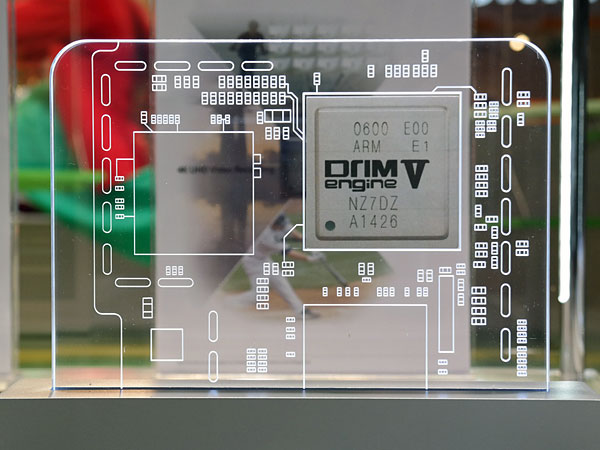
[one_half padding=”0 15px 0 0″]JK: There’s not much variability in them. Sometimes you’ll get thresholding changes and small numeric variables, but the image path is usually very locked down…[/one_half][one_half_last padding=”0 0px 0 15px”]JK: 里面没有太多可变性。有时你可以修改一些阀值和修改一些小数值,但图像的路径通常被严格锁定。[/one_half_last]
[one_half padding=”0 15px 0 0″]DE: It’s pretty much, a fixed pipeline.[/one_half][one_half_last padding=”0 0px 0 15px”]DE: 差不多是一条固定的管道。[/one_half_last]
[one_half padding=”0 15px 0 0″]JK: With a few tuning pieces, yeah.[/one_half][one_half_last padding=”0 0px 0 15px”]JK: 加上一些调节阀,对的。[/one_half_last]
[one_half padding=”0 15px 0 0″]DE: Whereas this is more configurable.[/one_half][one_half_last padding=”0 0px 0 15px”]DE: 而这个DRIMe V的ISP有更多的可配置性。[/one_half_last]
[one_half padding=”0 15px 0 0″]JK: Yes.[/one_half][one_half_last padding=”0 0px 0 15px”]JK: 是的。[/one_half_last]
[one_half padding=”0 15px 0 0″]DE: And it’s configurable not at the level of changing a firmware program, but you’re actually changing the hardwiring. There are switches you can use to change the configuration of the functional units?[/one_half][one_half_last padding=”0 0px 0 15px”]DE: 它的可配置性不是修改固件程序的程度,而实际上可以修改硬连线。是有能改变功能单元的设置的开关吗?[/one_half_last]
[one_half padding=”0 15px 0 0″]JK: Yeah, basically. And Samsung’s software people are all over it; they’re pretty sharp and I believe that we’re really going to be able to tap fully into the DRIMe V’s capabilities for the NX1.[/one_half][one_half_last padding=”0 0px 0 15px”]JK: 对,基本是这样。此外三星的软件人员都扑在上面了,他们很厉害,我想我们真的会在NX1上充分挖掘DRIMe V的性能。[/one_half_last]
[one_half padding=”0 15px 0 0″]DE: So even though it’s hardwired, some of the connectivity is programmable through the firmware, so we can actually look for continued “firmware” development that would continue to improve performance, including the parts that are implemented in hardware.[/one_half][one_half_last padding=”0 0px 0 15px”]DE: 所以尽管是硬连线,某些连接还是可以通过固件编程的,我们确实可以期待后续的“固件”开发不断改进性能,包括搭载在硬件上的部分。[/one_half_last]
[one_half padding=”0 15px 0 0″]JK: Yes.[/one_half][one_half_last padding=”0 0px 0 15px”]JK: 是的。[/one_half_last]
[one_half padding=”0 15px 0 0″]DE: So there may be significant improvements in the near future. That’s pretty interesting, because it sounds like it’s already starting out pretty capable.[/one_half][one_half_last padding=”0 0px 0 15px”]DE: 也许不久的将来会有一些显著的改进。这很有意思,因为听起来它刚起步已经有相当不错的能力。[/one_half_last]
[one_half padding=”0 15px 0 0″]JK: And not just image quality, there’s a lot going on in terms of programmability, like we talked about Samsung Auto-Shot mode before. Here’s the UI for it.[/one_half][one_half_last padding=”0 0px 0 15px”]JK: 而且不仅是画质,已经有很多在编程方面进行的改进,像我们之前谈到的三星自动拍摄模式。这是它的用户界面。[/one_half_last]
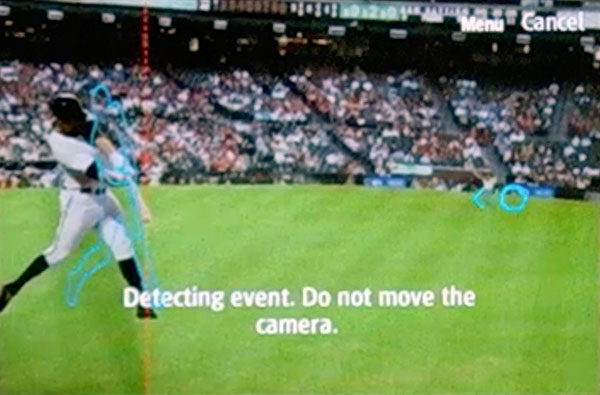
[one_half padding=”0 15px 0 0″]DE: Ah – I’d been wondering what it looked like![/one_half][one_half_last padding=”0 0px 0 15px”]DE: 啊,我一直想知道它是什么样的![/one_half_last]
[one_half padding=”0 15px 0 0″]JK: But that’s, you know, a perfect example of using that DRIMe V image processing. It does motion tracking at 240 frames per second, using hardware-based object recognition.[/one_half][one_half_last padding=”0 0px 0 15px”]JK: 不过你要知道的,这是使用DRIMe V图像处理的一个完美示例:它使用基于硬件的物体识别,能做到每秒240帧的运动跟踪。[/one_half_last]
[one_half padding=”0 15px 0 0″]DE: And did I read somewhere that it’s not just tracking the baseball, but it’s actually watching the bat as well?[/one_half][one_half_last padding=”0 0px 0 15px”]DE: 我好像在哪里读到过,它不仅仅在跟踪棒球,其实它也在观察球棒?[/one_half_last]
[one_half padding=”0 15px 0 0″]JK: No, just the ball reaching that position. The development team is working on things like that, but currently the hardware is just tracking the ball. What’s important to understand, though, is that this is all happening in hardware; that’s the way we can track something that fast.[/one_half][one_half_last padding=”0 0px 0 15px”]JK: 不,只是跟踪球到那个位置。开发团队正在努力开发类似的功能,但目前硬件只跟踪棒球。重要的是要知道这个全部是在硬件上实现的,所以我们才能那么快地跟踪一样东西。[/one_half_last]
[one_half padding=”0 15px 0 0″]DE: Really? Oh![/one_half][one_half_last padding=”0 0px 0 15px”]DE: 真的?噢![/one_half_last]
[one_half padding=”0 15px 0 0″]JK: Yeah, every four milliseconds, the DRIMe V hardware clocks in the image, searches for the ball, and calculates the ball’s position change and rate of change of position, and predicts the moment that the ball will pass the reference. The speed can vary over quite a range, but the hardware rejects objects moving too fast or too slow.[/one_half][one_half_last padding=”0 0px 0 15px”]JK: 没错。每4毫秒,DRIMe V的硬件记录下图像,搜索棒球并计算球的位移和位移的变化率,预测棒球通过参考线的瞬间。球速可以在相当的范围内变化,但硬件会无视移动太快或太慢的物体。[/one_half_last]
[one_half padding=”0 15px 0 0″]DE: Yeah, so whether the guy pitches a fast ball or a slow ball, the camera will track it – it’s not working on a fixed time delay, it’s actually measuring the speed.[/one_half][one_half_last padding=”0 0px 0 15px”]DE: 嗯,所以无论投手投出一个高速球还是低速球,相机都会进行跟踪:不是一个固定的延时,而真的在计算速度。[/one_half_last]
[one_half padding=”0 15px 0 0″]JK: Yeah, the ball speed can be anywhere from around 80km/h to around 160km/h [50 mph to 100 mph]. You can see that in the demo out in the booth — the laser dot “ball” alternates between fast and slow “pitches”.[/one_half][one_half_last padding=”0 0px 0 15px”]JK: 对,球速可以是大约80km/h到160km/h之间的任何速度[50mph到100mph]。你可以看外面展台的演示——激光”球”点在高速”投”和低速”投”间变化着。[/one_half_last]
[one_half padding=”0 15px 0 0″]DE: The pitcher is changing it up, yeah.[/one_half][one_half_last padding=”0 0px 0 15px”]DE: 投手正在改变速度,没错。[/one_half_last]
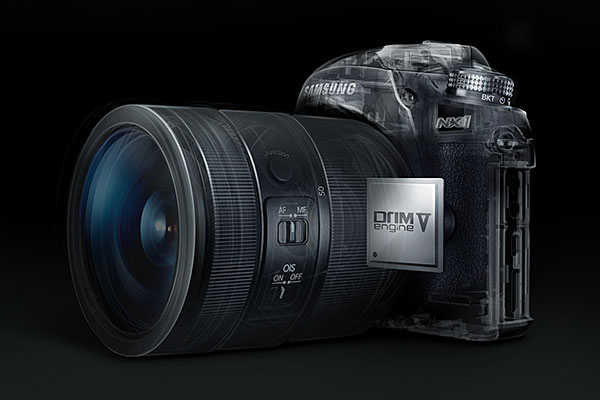 [one_half padding=”0 15px 0 0″]JK: Yeah, and you’ll see that the NX1’s pretty good about catching it at exactly the same point, regardless of the speed.[/one_half][one_half_last padding=”0 0px 0 15px”]JK: 嗯,你会看到NX1总能在同一个点捕捉到它,无论快慢。[/one_half_last]
[one_half padding=”0 15px 0 0″]JK: Yeah, and you’ll see that the NX1’s pretty good about catching it at exactly the same point, regardless of the speed.[/one_half][one_half_last padding=”0 0px 0 15px”]JK: 嗯,你会看到NX1总能在同一个点捕捉到它,无论快慢。[/one_half_last]
[one_half padding=”0 15px 0 0″]DE: How big is the window that it’ll recognize the ball? The UI shows a fairly small ball, how wide is the capture window for the ball?[/one_half][one_half_last padding=”0 0px 0 15px”]DE: 识别棒球的窗口有多大呢?用户界面显示的是一个相当小的球,捕捉棒球的窗口有多宽?[/one_half_last]
[one_half padding=”0 15px 0 0″]JK: Anywhere on that side of the screen.[/one_half][one_half_last padding=”0 0px 0 15px”]JK: 屏幕那边的任意位置。[/one_half_last]
[one_half padding=”0 15px 0 0″]DE: Oh, really? So anywhere that it enters that edge of the screen? That’s really interesting — when it’s clocking at 240 frames per second, is it just clocking data off of that part of the sensor? Is it just reading out a slice down the edge of the sensor, or does it read the whole frame?[/one_half][one_half_last padding=”0 0px 0 15px”]DE: 噢,真的吗?球进入到屏幕那边的任意位置?这真的很有意思:每秒记录240帧,是只从传感器上记录那部分数据吗?是只读取传感器那一边,还是读取整个幅面?[/one_half_last]
[one_half padding=”0 15px 0 0″]JK: The entire frame.[/one_half][one_half_last padding=”0 0px 0 15px”]JK: 整个幅面。[/one_half_last]
[one_half padding=”0 15px 0 0″]DE: Reading the entire frame? Wow…[/one_half][one_half_last padding=”0 0px 0 15px”]DE: 读取整个幅面?哇……[/one_half_last]
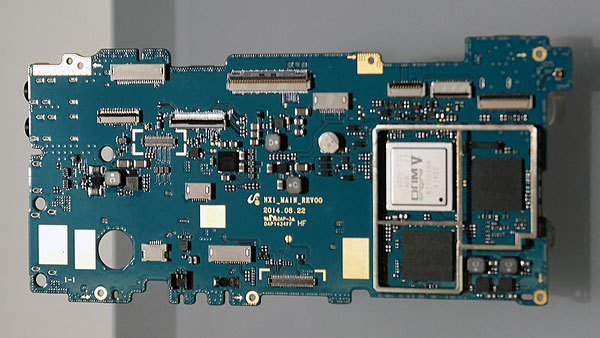
[one_half padding=”0 15px 0 0″]JK: It’s only searching for the ball on that side of the screen, though.[/one_half][one_half_last padding=”0 0px 0 15px”]JK: 尽管它只在屏幕的那边搜索棒球。[/one_half_last]
[one_half padding=”0 15px 0 0″]DE: So, when it’s clocking it off at 240 frames per second, is it not sampling all of the pixels? It reads the entire frame, but not every single pixel? Or does it read every single pixel?
[I’m having a hard time believing the latter.][/one_half][one_half_last padding=”0 0px 0 15px”]DE: 那么每秒记录下240帧的时候,它不是全像素采样对吗?它读取整个幅面,但不是每一个像素?还是它读取每一个像素?
[我很难相信是后者。][/one_half_last]
[one_half padding=”0 15px 0 0″]JK: Every single pixel.[/one_half][one_half_last padding=”0 0px 0 15px”]JK: 每一个独立像素。[/one_half_last]
[one_half padding=”0 15px 0 0″]DE: Wow, so 28 megapixels, at 240 times a second.
[This is mind-boggling faster than anything else we’ve ever seen before, outside very specialized and insanely expensive scientific systems.][/one_half][one_half_last padding=”0 0px 0 15px”]DE: 哇,所以是2800万像素,一秒钟内读取240次?
[这是令人难以置信的快,超过我们之前见过的任何设备,除了非常专业又异常昂贵的科研系统。][/one_half_last]
[one_half padding=”0 15px 0 0″]JK: Yeah, software can’t do that; this sort of thing is why we implemented such powerful hardware.[/one_half][one_half_last padding=”0 0px 0 15px”]JK: 没错,软件是做不到这点的,这是我们搭载了这么强大的硬件的原因。[/one_half_last]
[one_half padding=”0 15px 0 0″]DE: Yeah, hardware for it. You said that it’s a hardware object recognition system, so it can recognize other kinds of objects too?[/one_half][one_half_last padding=”0 0px 0 15px”]DE: 嗯,用硬件来完成。你说过它是硬件物体识别系统,那么它还能识别其它类型的物体吗?[/one_half_last]
[one_half padding=”0 15px 0 0″]JK: Yeah, it’s not specific to baseballs.[/one_half][one_half_last padding=”0 0px 0 15px”]JK: 是的,不限于棒球。[/one_half_last]

[one_half padding=”0 15px 0 0″]DE: So… faces and things like that too, or other objects?[/one_half][one_half_last padding=”0 0px 0 15px”]DE: 那么……面部或者类似的东西,或者其它物体?[/one_half_last]
[one_half padding=”0 15px 0 0″]JK: Face recognition is actually handled by a separate hardware block.[/one_half][one_half_last padding=”0 0px 0 15px”]JK: 面部识别其实是由一个独立的硬件模块控制。[/one_half_last]
[one_half padding=”0 15px 0 0″]DE: Oh, really? So even in the previous DRIMe, there was hardware for face recognition.[/one_half][one_half_last padding=”0 0px 0 15px”]DE: 噢,真的?所以包括之前的DRIMe就已经有用于面部识别的硬件了。[/one_half_last]
[one_half padding=”0 15px 0 0″]JK: Right. So far we’ve only announced the baseball application, but they’re working on other kinds of sports applications, too.[/one_half][one_half_last padding=”0 0px 0 15px”]JK: 对。目前为止我们只发布了棒球应用,不过他们(软件人员,译者注)也正在开发其它运动的应用。[/one_half_last]
[one_half padding=”0 15px 0 0″]DE: Ah – other kinds of sports. So it’s very much a sports application, but you’re looking at other sports besides baseball that it would be useful for. That’s really very interesting, it’s an interesting feature.
[Samsung wouldn’t give any hints of what other sports they might develop applications for, but I can easily imagine tennis, or the image of a ball coming off the golf club, etc.][/one_half][one_half_last padding=”0 0px 0 15px”]DE: 啊,其它类型的运动。所以很可能是一个运动应用,你在找棒球以外的运动,那会在……有用(套话,译者注)。很有意思,这是个有意思的功能(套话失败,译者注)。
[三星没有给任何关于他们可能开发应用的运动的暗示,但我能很容易想象到网球,或是高尔夫球脱出球杆的画面,等等。][/one_half_last]
[one_half padding=”0 15px 0 0″]I wanted to come back to the data-readout speed. Is the camera actually capable of recording video at 240 frames?[/one_half][one_half_last padding=”0 0px 0 15px”]我想回到数据读取速度上。这台相机究竟能在240帧的速率下录像吗?[/one_half_last]
[one_half padding=”0 15px 0 0″]JK: No.[/one_half][one_half_last padding=”0 0px 0 15px”]JK: 不行。[/one_half_last]
[one_half padding=”0 15px 0 0″]DE: Oh, because the codec isn’t fast enough to compress and format it?[/one_half][one_half_last padding=”0 0px 0 15px”]DE: 噢,是因为编码器不够快到足以压缩并格式化吗?[/one_half_last]
[one_half padding=”0 15px 0 0″]JK: Actually, we just didn’t implement that functionality, but the DRIMe V and the sensor could do it. When the guys in R&D were working on the Samsung Auto Shot feature, they recorded live 28 megapixel, 240 fps “video” to help with the debugging. We didn’t see there being an application for that, at least for very, very few people.[/one_half][one_half_last padding=”0 0px 0 15px”]JK: 说真的,我们只是没有落实到功能上,DRIMe V和传感器是可以做到的。研发人员在开发三星自动拍摄功能的时候,他们录下了2800万像素、240fps(帧每秒,译者注)的“视频”用于调试。我们看不到这个功能的用途,起码非常非常少的人会用到。[/one_half_last]
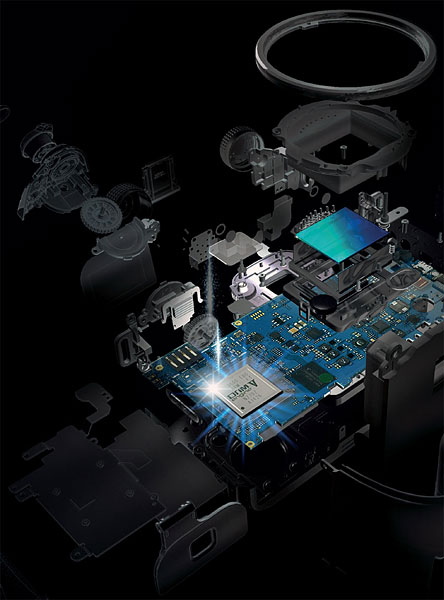 [one_half padding=”0 15px 0 0″]DE: Yeah, 28 megapixels at 240fps is an awful lot of data; that high a frame rate probably wouldn’t be very useful for still photographers, and there’s no video format that big or fast…[/one_half][one_half_last padding=”0 0px 0 15px”]DE: 是的,2800万像素240fps是非常多的数据,如此高的帧速大概对静态摄影师而言没有什么用,而且没有一种视频格式能……那么快那么多。[/one_half_last]
[one_half padding=”0 15px 0 0″]DE: Yeah, 28 megapixels at 240fps is an awful lot of data; that high a frame rate probably wouldn’t be very useful for still photographers, and there’s no video format that big or fast…[/one_half][one_half_last padding=”0 0px 0 15px”]DE: 是的,2800万像素240fps是非常多的数据,如此高的帧速大概对静态摄影师而言没有什么用,而且没有一种视频格式能……那么快那么多。[/one_half_last]
[one_half padding=”0 15px 0 0″]Going back to the processor itself how has your noise reduction processing changed as a result of having so much processing power available? What has that allowed you to do that you couldn’t do before the DRIMe V, in terms of the actual algorithms?[/one_half][one_half_last padding=”0 0px 0 15px”]回到处理器本身,既然有了那么强的处理能力,降噪的处理有什么改变呢?能让你们在算法上做哪些在DRIMe V之前做不了的呢?[/one_half_last]
[one_half padding=”0 15px 0 0″]JK: The DRIMe V actually has a lot of IPs [small hardware circuit blocks] dedicated to noise reduction. It’s pretty cool; there are a lot of them, and each one does a different type of noise reduction processing, all at the same time. The DRIMe IV didn’t have these.[/one_half][one_half_last padding=”0 0px 0 15px”]JK: DRIMe V实际上有很多IP(也许是Image Processor,图像处理器的缩写,译者注)[小的硬件电路模块]专门用于降噪。这个很棒,有很多IP,每一个都用于不同类型的降噪处理,都在同一时间进行。DRIMe IV没有这些。[/one_half_last]
[one_half padding=”0 15px 0 0″]DE: Really? So all these IPs can all be working in parallel doing their own noise reduction, and then some higher-level processor can come in and say, “Oh this is this type of image content here, so I’m going to use the output from this IP, but over here there’s different content, so I’m going to use the output from this other one”?[/one_half][one_half_last padding=”0 0px 0 15px”]DE: 真的吗?这些IP可以同时进行各自的降噪,然后某些更高级别的处理器能介入并说:“噢,这里的图像内容是这个类型的,我要用这个IP的处理结果,不过这里又有不同的内容,所以我要用另一个IP的处理结果”?[/one_half_last]
[one_half padding=”0 15px 0 0″]JK: Yeah, yeah.[/one_half][one_half_last padding=”0 0px 0 15px”]JK: 对,没错。[/one_half_last]
[one_half padding=”0 15px 0 0″]DE: Wow, I don’t know a lot about the details of image processors for digital cameras, but my impression has been that it was more software-driven. Here, though, all the different NR algorithms are being executed at the same time.[/one_half][one_half_last padding=”0 0px 0 15px”]DE: 哇,关于数码相机图像处理器的细节我知道的不是很多,但我的印象中更多是由软件驱动的。可是在这里所有不同的降噪算法都在同一时间执行。[/one_half_last]
[one_half padding=”0 15px 0 0″]JK: Yeah, hardware’s the only way to do this.[/one_half][one_half_last padding=”0 0px 0 15px”]JK: 没错,硬件是能做到这个的唯一方法。[/one_half_last]
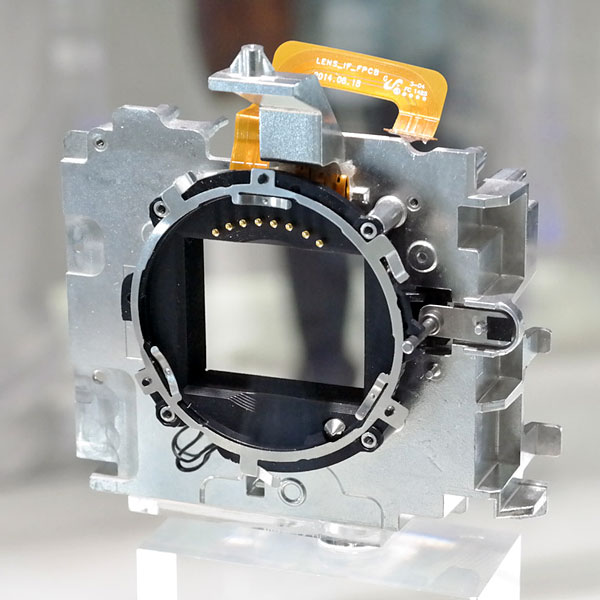 [one_half padding=”0 15px 0 0″]DE: Yeah. Wow, that’s really interesting. And yet, because of Samsung’s advanced processing, the power consumption is quite low. How does power consumption compare to DRIMe IV?[/one_half][one_half_last padding=”0 0px 0 15px”]DE: 对。哇,这太有意思了:然而,因为三星的先进制程,功耗相当的低。和DRIMe IV相比功耗如何?[/one_half_last]
[one_half padding=”0 15px 0 0″]DE: Yeah. Wow, that’s really interesting. And yet, because of Samsung’s advanced processing, the power consumption is quite low. How does power consumption compare to DRIMe IV?[/one_half][one_half_last padding=”0 0px 0 15px”]DE: 对。哇,这太有意思了:然而,因为三星的先进制程,功耗相当的低。和DRIMe IV相比功耗如何?[/one_half_last]
[one_half padding=”0 15px 0 0″]JK: It’s actually a bit lower.[/one_half][one_half_last padding=”0 0px 0 15px”]JK: 事实上DRIMe V功耗更低一点。[/one_half_last]
[one_half padding=”0 15px 0 0″]DE: It actually became lower, even though, even though there was such a huge jump in horsepower?[/one_half][one_half_last padding=”0 0px 0 15px”]DE: 事实上还更低?即使,即使有那么大幅的功率提升?[/one_half_last]
[one_half padding=”0 15px 0 0″]JK: Yeah, because it’s a new semiconductor process for the DRIMe V.[/one_half][one_half_last padding=”0 0px 0 15px”]JK: 对,因为DRIMe V用了新的半导体工艺。[/one_half_last]
[one_half padding=”0 15px 0 0″]DE: I think you said earlier that the DRIMe V had about twice the processing power, does that mean twice as many hardware units?[/one_half][one_half_last padding=”0 0px 0 15px”]DE: 我想你之前说过DRIMe V有大约两倍的处理能力,是说有两倍的硬件单元?[/one_half_last]
[one_half padding=”0 15px 0 0″]JK: Yeah. It’s not just the number of units, though; with the 32nm design rules, there are a lot more gates in each processing unit.[/one_half][one_half_last padding=”0 0px 0 15px”]JK: 对,不过不仅是单元的数量。得益于32nm的设计线宽,每个处理单元有了更多的闸极。[/one_half_last]
[one_half padding=”0 15px 0 0″]DE: And how many regular CPUs are there?[/one_half][one_half_last padding=”0 0px 0 15px”]DE: 有多少个普通CPU在里面?[/one_half_last]
[one_half padding=”0 15px 0 0″]JK: Five general-purpose cores.[/one_half][one_half_last padding=”0 0px 0 15px”]JK: 五个通用核心。[/one_half_last]

[one_half padding=”0 15px 0 0″]JK: Another important point is that the DRIMe V has the world’s first HEVC codec. (aka H.265)[/one_half][one_half_last padding=”0 0px 0 15px”]JK: 另一个重点是DRIMe V是世界上第一个拥有HEVC(又名H.265)编解码器的。[/one_half_last]
[one_half padding=”0 15px 0 0″]DE: Ah, yes. I was just about to ask about that. So it’s also doing the H.265 encoding. And that’s presumably also hardware, I would think.[/one_half][one_half_last padding=”0 0px 0 15px”]DE: 啊,对,我刚要问这个。所以它也能做H.265的编码,我想大概也是硬件在做。[/one_half_last]
[one_half padding=”0 15px 0 0″]JK: Right. If you check, I think it’s the first HEVC codec in a camera. That makes it pretty amazing as well. H.265 is a lot more sophisticated than H.264; you can get similar image quality with only half the data rate.[/one_half][one_half_last padding=”0 0px 0 15px”]JK: 没错,如果你核对一下,我想这是HEVC编解码器第一次出现在相机里。它也确实做得很好,H.265比H.264先进很多,你只需一半的码率就能得到相似的画质。[/one_half_last]
[one_half padding=”0 15px 0 0″]DE: Ah, so for instance 100 MBits/s with H.265 is like 200 MBits/s with H.264.[/one_half][one_half_last padding=”0 0px 0 15px”]DE: 啊,比方说100MBits/s(百万比特率每秒,视频码率单位,译者注)的H.265看上去就像200 MBits/s的H.264。[/one_half_last]
[one_half padding=”0 15px 0 0″]JK: Yeah, pretty much. Another important thing is that the NX1 has a low-latency EVF.[/one_half][one_half_last padding=”0 0px 0 15px”]JK: 对,差不多是这样。还有一个重点是NX1配备了一个低延迟的EVF(电子取景器,译者注)。[/one_half_last]
[one_half padding=”0 15px 0 0″]DE: Latency, oh yeah, actually, I did want to ask that. So does that mean for viewfinder, because it says five milliseconds. So is that 200 frames a second?[/one_half][one_half_last padding=”0 0px 0 15px”]DE: 延迟,噢对,其实我早就想问了。延迟是5毫秒,是指取景器吗?所以是每秒200帧?[/one_half_last]
[one_half padding=”0 15px 0 0″]JK: No, actually the display refreshes at about 54 fps, but the key thing is that the EVF and the sensor are synchronized. The two are genlocked, so there’s always just a 5 ms lag between what’s hitting the sensor and what’s being displayed on the EVF’s current scan line. I think we’re the only ones who can do this.[/one_half][one_half_last padding=”0 0px 0 15px”]JK: 不,实际上显示器的刷新率大约是54fps,但关键是EVF和传感器是同步的。两者信号同步,所以从光线抵达传感器到显示在EVF当前扫描线上仅有5ms的延迟,我想我们是唯一能做到这个的。[/one_half_last]
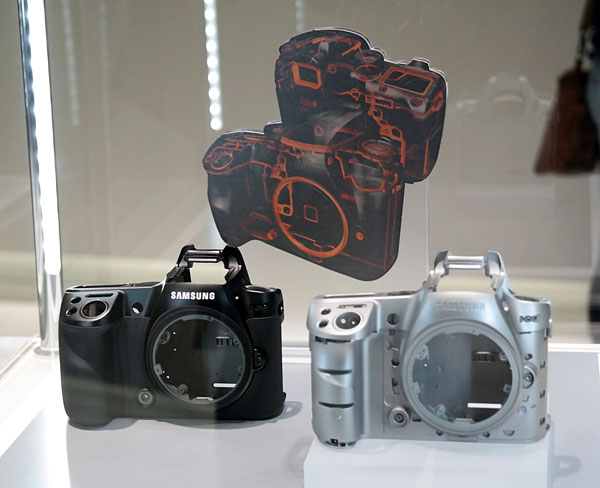 [one_half padding=”0 15px 0 0″]DE: The video streaming through HDMI port, is that 4:2:2 on everything?[/one_half][one_half_last padding=”0 0px 0 15px”]DE: 所有通过HDMI端口输出的视频流都是4:2:2(色度抽样比例之一,译者注)吗?[/one_half_last]
[one_half padding=”0 15px 0 0″]DE: The video streaming through HDMI port, is that 4:2:2 on everything?[/one_half][one_half_last padding=”0 0px 0 15px”]DE: 所有通过HDMI端口输出的视频流都是4:2:2(色度抽样比例之一,译者注)吗?[/one_half_last]
[one_half padding=”0 15px 0 0″]JK: It’s 4:2:2 out the HDMI 1.4 port; it’s 4:2:0 as it goes to the SD. And it’s H.265 to the card for both HD and 4K, so whatever video mode you’re saving to SD card, it’s using H.265, so you’re going to get much more efficient and better-quality HD out of it.[/one_half][one_half_last padding=”0 0px 0 15px”]JK: 在HDMI 1.4端口上是4:2:2输出;到SD卡的是4:2:0。输出到卡上的高清和4K视频都是H.265,所以无论你选择什么视频模式存储到SD卡都是用H.265编码,你就能从中获得更高效率和高质量的高清视频。[/one_half_last]
[one_half padding=”0 15px 0 0″]DE: What’s the maximum bitrate to the card?[/one_half][one_half_last padding=”0 0px 0 15px”]DE: 存储到卡上的最大码率是多少?[/one_half_last]
[one_half padding=”0 15px 0 0″]JK: I don’t have a bitrate yet, but it’s much more efficient compression. It requires more computing power to do it, but just as a rough example, I can run a Class 10 card through this, no problem. To do H.264 on, let’s say, a competitive piece, I need a UHS-3 card.[/one_half][one_half_last padding=”0 0px 0 15px”]JK: 我还不知道码率的数据,但H.265在压缩比上要高效得多。它需要更多的计算能力才行,一个大概的例子,我能用c10(SDHC卡速等级,最低写入10mb/s,译者注)的卡保存H.265,没问题,如果是H.264,假设差不多的情况,我需要UHS-3(SDHC卡速等级,最低写入30mb/s,译者注)的卡。[/one_half_last]
[one_half padding=”0 15px 0 0″]DE: So it’s really a whole different metric with H.265; you can’t just directly compare megabits per second with data rates for H.264. It seems that 100 megabits here is going to be like 200 megabits there, so just looking at the data rate isn’t going to translate directly into video quality.[/one_half][one_half_last padding=”0 0px 0 15px”]DE: H.265真的是一个完全不同的标准,你不能直接和H.264比较每秒多少MBits的码率。看上去这里的100MBits和那里的200MBits差不多,但只看码率是不能直接转化成视频质量的。[/one_half_last]
[one_half padding=”0 15px 0 0″]JK: Right, right. The image quality for H.265’s better. The noise reduction, or the compression artifacting is less, but it’s twice as efficient in terms of space.[/one_half][one_half_last padding=”0 0px 0 15px”]JK: 对,没错。H.265的画质更好,降噪啊,还有更少的压缩伪像,不过在存储空间上有两倍的效率。[/one_half_last]
[one_half padding=”0 15px 0 0″]DE: That’s about it for my questions, and I see we’re also about out of time. Wow, that was sure a lot of ground we covered, thanks for the time and all the info![/one_half][one_half_last padding=”0 0px 0 15px”]DE: 我的问题问得差不多了,时间也快到了。哇,我们真的谈到了很多内容,感谢你的时间和所有的这些信息![/one_half_last]
[one_half padding=”0 15px 0 0″]JK: No problem![/one_half][one_half_last padding=”0 0px 0 15px”]JK: 不客气![/one_half_last]

小结:
对比度对焦最低EV-4,相位对焦最低EV-2;
有效距离15米的图形AF辅助光;
DRIMe V图像处理器,采用32nm工艺,可配置ISP,5个通用核心,性能比前代提升2倍(2.8倍),功耗却更低;
自动拍摄(Auto-Shot),通过240fps的物体跟踪自动拍摄棒球击打瞬间;
拥有240fps全像素读取能力的强大处理器和芯片;
多种硬件降噪算法,能区分图像内容和噪点;
仅5ms的低延迟EVF;
HEVC/H.265编码器,相同码率接近两倍画质。

Leave a Reply